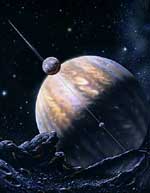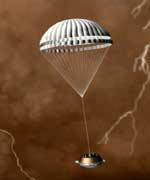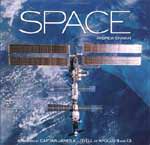
Three programs got the USA to the moon. The Mercury program, conceived before Kennedy’s speech, was to achieve orbital flight and the recovery of a manned satellite. The Gemini program, an indirect result of Kennedy’s speech, had quickly to teach NASA if one could travel to the moon and how best to do so. The Apollo program used all the lessons learned and had to place a human on the moon. Or, in other words, Mercury was the child, Gemini was the teacher, and Apollo was the graduate.
Harland’s book opens with a brief description of the Mercury program, its association with von Braun and the prerequisites for a manned satellite. Here we see that ocean explorers had one advantage. They could stretch and walk about their ships! The Mercury capsule was effectively a flying chair encased in a protective steel shell. Once the challenge of the Moon race began, the Gemini capsule ensued. To test rendezvous requirements, two people were needed. One flew the craft while the other confirmed the rendezvous. Much as the Gemini capsule was second generation and fit two people, it wasn’t much better than its predecessor. Or as one pilot put it, ‘it was like sitting in the front end of a Volkswagen for days’. Apparently functionality kept winning over form.
Much of the remainder of the book presents each of the Gemini launches in a chronological order. The focus is on the human aspects of the Gemini program, principally the pilots. Benign actions and casual banter are judiciously presented. The early flights assessed endurance abilities. Some experimental work occurred but you will discover that even being in orbit can be boring. For example, the astronauts were advised to bring fiction books to while away the time. You will also discover how a House investigation was convened to discuss how sandwich crumbs ended up floating around the cabin.
A typical chapter begins with a description of the mission for the flight. Often it was an extension or elaboration of a preceding flight so the chapters smoothly flow together. Sometimes outside interests arose as the Air Force wanted to know if their special backpack could allow an astronaut to ‘visit’ an orbiting USSR satellite. The launch is also covered in detail. Sometimes they were tricky; one had a launch window of two seconds (it succeeded!). The flight themselves are presented firsthand by the use of conversations between the crew and the ground controllers of the stations of the World Wide Tracking Network (WWTN). When there is lots going on, these chapters get extensive. When an endurance record is set, the topics change such as centring on the best way to sleep in space. A brief summary concludes each chapter, usually including a reference to how the results affect future Gemini missions or Apollo designs.
One of the best feelings Harland raises is the sense of urgency. Though no or little information was known about space flight, a lot had to be learned very quickly. The ten Gemini flights were launched at an average of one every two months. There was little room for error even though target satellites failed or onboard equipment performed inadequately. Just looking at the pilots’ work cycle clearly shows this. First they help define their flights mission(s). Next, they train. Then they adapt to any mission specific tasks. Their launch pad experience may transcend many countdowns and mission scrubs. Finally they go and undertake their mission. Afterward they go through debriefings. Afterward they complete a stint as communications officer at one of the WWTN sites and then they’re back training for their next mission. Nothing like a deadline set by a president to provide inspirational feelings and timeliness.
This book does not contain much technical description of the Gemini craft, its launcher or the mathematical trickeries of orbital mechanics. There are descriptions but really, this book is about the people, their actions and their emotions. Many photographs identify the astronauts and their achievements. Perhaps some will find this a trifle too casual such as reading how an astronaut’s wife gave birth while he was in orbit. Yet this vantage contributes to the depiction of these craft as for humans and controlled by humans. The empirical data can happily stay in text books, this one is for the people.
The early explorers knew how to sail but didn’t know what they would find during their voyages. NASA’s Gemini program taught the USA how to sail through space to place their feet on the ever present moon. In David Harland’s book ,’How NASA Learned to Fly in Space’ you can read what they had to learn and how they learned it so that they, like the ocean’s explorers before them, could extend the travelogue of humankind.
To get your own copy, visit Countdown Creations.
Review by Mark Mortimer



